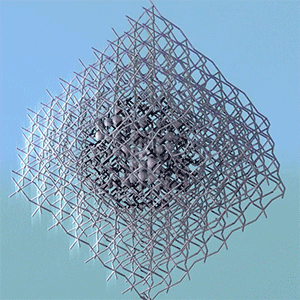
Hyper-efficient LED technologies could enable applications from the visible-light LED bulbs in every home, to new displays, to gesture recognition using near-infrared wavelengths.
It’s snack time: you have a plain oatmeal cookie, and a pile of chocolate chips. Both are delicious on their own, but if you can find a way to combine them smoothly, you get the best of both worlds.
Researchers in The Edward S. Rogers Sr. Department of Electrical & Computer Engineering used this insight to invent something totally new: they’ve combined two promising solar cell materials together for the first time, creating a new platform for LED technology.
The team designed a way to embed strongly luminescent nanoparticles called colloidal quantum dots (the chocolate chips) into perovskite (the oatmeal cookie). Perovskites are a family of materials that can be easily manufactured from solution, and that allow electrons to move swiftly through them with minimal loss or capture by defects.
The work is published today in the international journal Nature.
“It’s a pretty novel idea to blend together these two optoelectronic materials, both of which are gaining a lot of traction,” says Xiwen Gong, one of the study’s lead authors and a PhD candidate working with Professor Ted Sargent. “We wanted to take advantage of the benefits of both by combining them seamlessly in a solid-state matrix.”
The result is a black crystal that relies on the perovskite matrix to ‘funnel’ electrons into the quantum dots, which are extremely efficient at converting electricity to light.
“When you try to jam two different crystals together, they often form separate phases without blending smoothly into each other,” says Dr. Riccardo Comin, a post-doctoral fellow in the Sargent Group. “We had to design a new strategy to convince these two components to forget about their differences and to rather intermix into forming a unique crystalline entity.”
The main challenge was making the orientation of the two crystal structures line up, called heteroexpitaxy. To achieve heteroepitaxy, Gong, Comin and their team engineered a way to connect the atomic ‘ends’ of the two crystalline structures so that they aligned smoothly, without defects forming at the seams. “We started by building a nano-scale scaffolding ‘shell’ around the quantum dots in solution, then grew the perovskite crystal around that shell so the two faces aligned,” explained coauthor Dr. Zhijun Ning, who contributed to the work while a post-doctoral fellow at UofT and is now a faculty member at ShanghaiTech.
The resulting heterogeneous material is the basis for a new family of highly energy-efficient near-infrared LEDs. Infrared LEDs can be harnessed for improved night-vision technology, to better biomedical imaging, to high-speed telecommunications.
Read more: Engineered hybrid crystal opens new frontiers for high-efficiency lighting
The Latest on: Quantum dots and perovskite
[google_news title=”” keyword=”Quantum dots and perovskite” num_posts=”10″ blurb_length=”0″ show_thumb=”left”]
via Google News
The Latest on: Quantum dots and perovskite
- 💻 Invention of a stretchable quantum dot displayon April 26, 2024 at 4:00 am
The quest to create inherently stretchable displays has begun. Traditional displays are limited by rigid and inflexible components. It is therefore imperative to find innovative materials and ...
- “Truly Amazing” – Quantum Dots Successfully Synthesized Inside Living Cells!on April 24, 2024 at 11:43 pm
A recent study published in the journal National Science Review demonstrates the synthesis of quantum dots (QDs) in the nucleus of live cells. The research was conducted by Dr. Hu Yusi, Associate ...
- Announcing the birth of QUIONE, a unique analog quantum processoron April 22, 2024 at 1:31 pm
Quantum physics requires high-precision sensing techniques to delve deeper into the microscopic properties of materials. From the analog quantum processors that have emerged recently, quantum-gas ...
- Leaked Document Reveals Russia’s Latest Efforts to Weaken the Weston April 18, 2024 at 7:09 am
This week we examine a newly leaked secret document outlining Russia’s aims to wage a campaign aimed at weakening the U.S. and other western nations.
- Shaping the Solar Panel Industry Future: Innovations to Comeon April 18, 2024 at 1:45 am
Solar panels have long become one of the most beloved energy sources among green enthusiasts people willing to cut their energy bills and those fighting climate change That said as ...
- “Neutronic Molecules” – Neutrons Meet Quantum Dots in Groundbreaking MIT Discoveryon April 16, 2024 at 4:19 am
Study shows neutrons can bind to nanoscale atomic clusters known as quantum dots. The finding may provide insights into material properties and quantum effects. Neutrons are subatomic particles that ...
via Bing News










